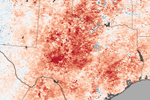A prolonged drought in East Africa is bringing many of the region’s impoverished to their knees: the World Food Program (WFP) is warning that 10 million people in the region are facing severe shortages. While not dubbed a famine yet, experts say it could become one. Meanwhile, a recent study by FEWS NET/USGS has revealed that the current drought is the worst in 11 of 15 East African regions since 1950-51. Worsening droughts are one of the predictions for the region as the world grows warmer.
“The World Food Program is aiming to feed more than 6 million of the most vulnerable, but resources are thin and at the very moment that we should be ramping up operations, we have been scaling back some programmes in Ethiopia and Somalia,” said Josette Sheeran, executive director of WFP. The WFP has seen resources dwindle from the international community since Wall Street’s economic crisis in 2008.
Mark Bowden, the UN Resident and Humanitarian Coordinator for Somalia, estimates that assistance for conflict-torn Somalia is currently only 40 percent funded. Hunger is pushing tens of thousands of Somalians into Kenyan refugee camps every week.
“In some areas the situation is close to that of famine. We are at the emergency stage which precedes that of famine. But the situation can still evolve,” Elisabeth Byrs, spokeswoman for the UN Office for the Coordination of Humanitarian Affairs, told the AFP.
The WFP estimates that 3.5 million people in Kenya, 3.2 million in Ethiopia, 2.5 million in Somalia, over half a million in Uganda, and over a hundred thousand in Dijbouti are in need of food assistance. Rising food prices have worsened the situation.
While the people of East Africa are accustomed to drought periods, the current and long-lasting drought is unusual. A study this year in Climate Dynamics found that dry conditions in East Africa would likely continue due to climate change.
“Global temperatures are predicted to continue increasing, and we anticipate that average precipitation totals in Kenya and Ethiopia will continue decreasing or remain below the historical average,” said USGS scientist Chris Funk. “The decreased rainfall in eastern Africa is most pronounced in the March to June season, when substantial rainfall usually occurs. Although drought is one reason for food shortages, it is exacerbated by stagnating agricultural development and continued population growth.”
The researchers say while such predictions are complex and difficult, the warming Indian Ocean will likely keep East Africa drier than recent averages. This does not mean, however, that the region won’t see periods of rain and flooding, only that overall rainfall is expected to decrease. Globally, over the past year many parts of the world have seen extreme weather conditions in the form of unprecedented floods, droughts, and wildfires; last year was also the warmest on record, tied with 2005.
If predictions for East Africa under climate change hold true, hunger crises in the region are likely to become even more frequent events.
“A slowly evolving regional hunger crisis may not have the immediate impact of a mega-emergency like the Haitian earthquake, or Pakistan floods, but the drought and rising malnutrition in the Horn affects more people and its effects are equally devastating,” added Ms. Sheeran.
Related articles
Burning up: warmer world means the rise of megafires
(05/12/2011) Megafires are likely both worsened by and contributing to global climate change, according to a new United Nations report. In the tropics, deforestation is playing a major role in creating giant, unprecedented fires.
Are US floods, fires linked to climate change?

(04/28/2011) The short answer to the question of whether or not on-going floods in the US Midwest and fires in Texas are linked to a warming Earth is: maybe. The long answer, however, is that while it is difficult—some argue impossible—for scientists to link a single extreme weather event to climate change, climate models have long shown that extreme weather events will both intensify and become more frequent as the world continues to heat up. In other words, the probability of such extreme events increases along with global average temperature.
Last year’s drought hit Amazon hard: nearly a million square miles impacted

(03/29/2011) A new study on its way to being published shows that the Amazon rainforest suffered greatly from last year’s drought. Employing satellite data and supercomputing technology, researchers have found that the Amazon was likely hit harder by last year’s drought than a recent severe drought from 2005. The droughts have supported predictions by the Intergovernmental Panel on Climate Change’s (IPCC) that climate change, among other impacts, could push portions of the Amazon to grasslands, devastating the world’s greatest rainforest. “The greenness levels of Amazonian vegetation—a measure of its health—decreased dramatically over an area more than three and one-half times the size of Texas and did not recover to normal levels, even after the drought ended in late October 2010,” explains the study’s lead author Liang Xu of Boston University.







